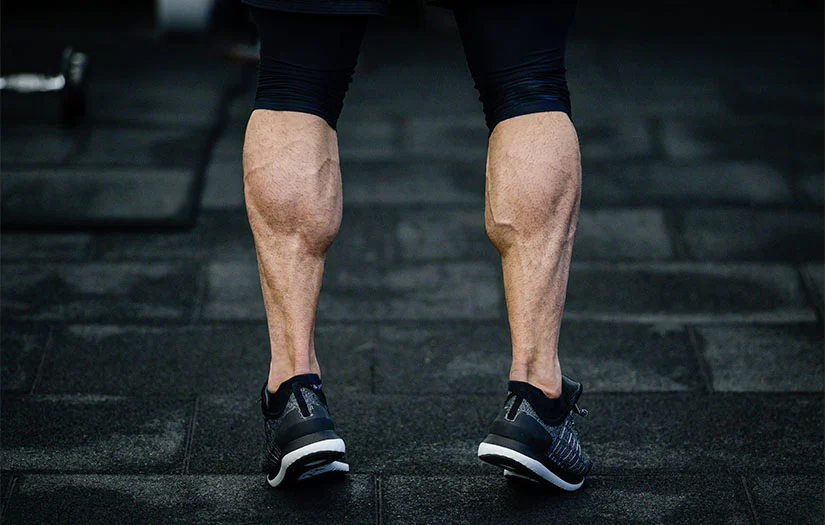
calf-workouts
Table of Contents
Building strong legs is key to any fitness plan. Yet, many overlook calf training. Strong calf exercises make your legs look better, improve balance, and boost athletic skills.

To develop strong legs, you need a balanced workout. This includes exercises for all muscle groups, like the calf muscles. Here, we’ll look at 7 calf exercises to strengthen your legs.
Key Takeaways
- Calf exercises are essential for overall leg development.
- Strong calf muscles improve balance and athletic performance.
- A well-rounded leg routine includes exercises for all muscle groups.
- The 7 exercises outlined can significantly enhance calf strength.
- Incorporating these exercises can lead to more powerful legs.
Why Strong Calves Matter for Overall Leg Development
Strong calves are more than just a pretty feature. They are key to having powerful legs. They help with strength and stability in the lower limbs.
Aesthetic Benefits of Well-Developed Calves
Strong calf muscles make your legs look better. They add balance and shape. This is great for athletes and anyone who likes a toned look.
Functional Advantages in Sports and Daily Activities
Calves are important for more than just looks. They help with running, jumping, and climbing stairs. They give you the power and endurance you need.
In sports like soccer, basketball, and tennis, strong calves are crucial. They help you move faster and jump higher. This can make a big difference in your performance.
Understanding Calf Anatomy: The Gastrocnemius and Soleus
To train your calf muscles well, you need to know what they are. The calf muscles are made up of two main muscles: the gastrocnemius and the soleus. These muscles help move your foot and ankle. They are key for leg strength and stability.
The gastrocnemius muscle is easy to see. It has two parts that start from the thigh bone. This muscle bends your ankle and knee, making it important for both joints.
The Two-Headed Gastrocnemius Muscle
The gastrocnemius muscle is special because it has two heads. The medial head is bigger than the lateral head. It’s near the skin’s surface and is the most visible part of the calf. To work this muscle well, you need to do exercises that target both heads.
Key functions of the gastrocnemius include:
- Ankle plantarflexion (pointing the foot downward)
- Knee flexion (bending the knee)
The Often-Neglected Soleus Muscle
Underneath the gastrocnemius lies the soleus muscle. It’s just as important for calf growth. The soleus muscle is flat and wide, connecting the lower leg bones to the heel bone. It’s key for bending the ankle, especially when the knee is bent.
| Muscle | Primary Function | Secondary Function |
|---|---|---|
| Gastrocnemius | Ankle plantarflexion | Knee flexion |
| Soleus | Ankle plantarflexion | Stabilizing the ankle |
Knowing how the gastrocnemius and soleus muscles work is crucial for a good calf workout. By focusing on both, you can build a stronger, more balanced leg.
Equipment Needed for Effective Calf Exercises
To train your calves well, you need the right tools. This can be done at the gym or at home. The best part is, you don’t need expensive equipment to start.
Gym Equipment Options
At the gym, you have several tools for calf training. The most common ones are:
- Standing Calf Raise Machine
- Seated Calf Raise Machine
- Leg Press Machine (for calf presses)
These machines help you do different calf exercises. They target different muscle fibers.
| Equipment | Primary Function | Muscle Targeted |
|---|---|---|
| Standing Calf Raise Machine | Standing calf raises | Gastrocnemius |
| Seated Calf Raise Machine | Seated calf raises | Soleus |
| Leg Press Machine | Calf presses | Both Gastrocnemius and Soleus |
At-Home Alternatives
Working out at home is also great for calf training. You can use:
- Bodyweight
- Resistance bands
- Step or platform for calf raises
These options are easy and affordable. They help you keep up with your calf training at home.
7 Most Effective Calf Exercises That Actually Work
To make your legs stronger, focus on calf exercises that work both the gastrocnemius and soleus muscles. Strong calf muscles look good and help with strength and sports performance.
1. Standing Calf Raises
Standing calf raises are key for calf training. They mainly work the gastrocnemius muscle, which shapes your calves.
Proper Form and Technique
To do standing calf raises right, stand on a step with your heels off the edge. Slowly lift up on your tiptoes, then lower back down fully.
Variations and Progressions
Change standing calf raises by using different tools like a machine or dumbbells. Increase the weight or reps to get stronger.
2. Seated Calf Raises
Seated calf raises focus on the soleus muscle, often missed but important for calf growth.
Targeting the Soleus Muscle
Sitting down lets you focus on the soleus without the gastrocnemius. Use a machine or sit on a bench with weights.
Weight Selection and Rep Ranges
Pick a weight for the right number of reps with good form. Aim for 12-15 reps to work the soleus well.
3. Donkey Calf Raises
Donkey calf raises target the gastrocnemius, often done with a partner or a specific machine.
Setup and Execution
Stand with your feet on a step and bend forward at the hips. Have a partner on your back or use a machine.
Benefits Over Traditional Raises
Donkey calf raises give more motion and might work your muscles harder than standing raises.
4. Single-Leg Calf Raises
Single-leg calf raises are great for fixing muscle imbalances and boosting calf strength.
Addressing Muscle Imbalances
Training one leg at a time helps find and fix strength differences between legs.
Progression Strategies
Get stronger by adding more weight, reps, or sets. Try different speeds for more challenge.
5. Jump Rope Exercises
Jump rope exercises are a fun way to work your calf muscles. They also boost your heart health and explosive power.
Technique for Maximum Calf Engagement
Use quick, light steps and keep your knees slightly bent to absorb shock.
Interval Training Protocols
Switch between fast jumping and rest to engage your calves and heart more.
6. Box Jumps for Explosive Calf Power
Box jumps are plyometric exercises that work your calf muscles and others, improving explosive power.
Safety Considerations
Make sure you have the right technique and a safe place. Start with lower boxes and go up as you get stronger.
Height Progression
As you get more powerful, jump from higher boxes to keep challenging your calf muscles.
7. Calf Press on Leg Press Machine
The calf press on a leg press machine works both the gastrocnemius and soleus muscles well.
Machine Setup and Foot Positioning
Adjust the leg press machine to fit you, with your heels hanging off the platform.
Heavy vs. Light Weight Approaches
Use heavy weights for fewer reps to build strength. Lighter weights for more reps to improve muscle endurance.
Common Mistakes That Limit Calf Growth
Growing strong calves needs more than just regular workouts. It also means avoiding common mistakes. Many people find it hard to build their calf muscles because of simple errors in their training.
Insufficient Training Volume and Frequency
One big mistake is not training your calves enough. Like any muscle, they need enough work to grow. You should do different calf exercises often. Try to do 3-4 sets each time and train your calves 2-3 times a week.
Poor Range of Motion During Exercises
Another mistake is not using the full range of motion in calf exercises. To really work your calf muscles, you need to move fully. This means lowering your heels as low as you can and then raising them as high as you can. Avoid partial reps because they don’t work as well.
Neglecting Progressive Overload
Not increasing the challenge over time is another mistake. Progressive overload means slowly adding more weight or reps to your workouts. For calf raises, this could mean using more weight or doing more reps and sets. Consistency and progressive overload are key for muscle growth.
By avoiding these mistakes, you can improve your calf training. Focus on doing exercises right, training enough, and increasing the challenge. This will help you grow and strengthen your calf muscles.
How to Program Calf Exercises Into Your Workout Routine
Effective calf training needs a balanced approach. This includes thinking about how often, how much, and how to rest. To create a good calf workout routine, it’s key to know how to mix these elements well.
Frequency Recommendations
Training frequency is key for calf development. Aim to train your calves 2-3 times a week. This helps stimulate the muscles without overdoing it, which can cause overtraining.
Volume and Intensity Guidelines
The volume and intensity of your calf workouts should match your fitness goals. For muscle growth, do 3-4 sets per exercise with 8-12 reps. As you get stronger, increase the weight to keep challenging your muscles.
| Exercise | Sets | Reps |
|---|---|---|
| Standing Calf Raise | 3 | 10 |
| Seated Calf Raise | 3 | 12 |
| Calf Press | 4 | 8 |
Recovery Considerations
Recovery is crucial for muscle growth and repair. Make sure to rest your calf muscles for at least 48 hours before working them again. Proper nutrition and hydration also help with recovery.

Sample Calf Workout Routines for Different Goals
Calf workout routines can be tailored to fit your fitness goals and level. Whether you’re starting out, looking to grow your muscles, or aiming for more power, the right routine is key.
Here are sample calf workout routines for different levels. Each is designed to be effective and easy to add to your routine.
Beginner Routine
Beginners focus on building a strong base. This means doing fewer sets and reps, with a focus on proper form.
- Standing Calf Raises: 3 sets of 12 reps
- Seated Calf Raises: 3 sets of 12 reps
Intermediate Program
Intermediate lifters should do more and harder workouts. This means adding more sets and reps, or trying new exercises.
- Standing Calf Raises: 4 sets of 15 reps
- Seated Calf Raises: 4 sets of 15 reps
- Donkey Calf Raises: 3 sets of 12 reps
Advanced Training Split
Advanced athletes need a complex routine. This should target the calf muscles from different angles and include explosive exercises.
- Standing Calf Raises: 5 sets of 20 reps
- Seated Calf Raises: 5 sets of 20 reps
- Box Jumps: 4 sets of 15 reps
- Jump Rope: 3 sets of 30 seconds
| Fitness Level | Exercises | Sets/Reps |
|---|---|---|
| Beginner | Standing & Seated Calf Raises | 3 sets of 12 reps |
| Intermediate | Standing, Seated, & Donkey Calf Raises | 4 sets of 15 reps |
| Advanced | Standing, Seated, Box Jumps, & Jump Rope | 5 sets of 20 reps (varies) |
By choosing the right calf workout routine for your level and goals, you can make steady progress. Remember, sticking to it and doing it right is key to great calf muscles.
Stretching and Recovery Techniques for Calf Development
To grow your calf muscles, you need to stretch and recover well. Stretching and recovery are key to growing your calf muscles and avoiding injuries.
Essential Calf Stretches
Calf stretches help improve flexibility and reduce soreness. Here are some important stretches to do:
- Standing Calf Stretch: Stand facing a wall with one hand on it for balance. Step back with one foot, keeping your heel down. Bend the front knee and lean forward, stretching your calf. Hold for 15-30 seconds and switch legs.
- Seated Calf Stretch: Sit on the floor with your legs straight out. Lean forward, reaching for your toes, and hold for 15-30 seconds.
- Wall Push Calf Stretch: Stand with your feet shoulder-width apart, then lean against a wall with your hands. Slowly slide your feet back, keeping your heels down, until you feel a stretch in your calves.

Recovery Methods to Enhance Growth
Recovery is as important as stretching for calf growth. Here are some effective recovery methods:
- Foam Rolling: Use a foam roller to roll out your calf muscles, helping to reduce muscle soreness and improve circulation.
- Compression Sleeves: Wear compression sleeves to enhance blood flow and reduce muscle oscillation during exercise.
- Proper Nutrition: Make sure you eat enough protein and nutrients to support muscle recovery and growth.
- Adequate Rest: Give your calf muscles enough time to recover between intense workouts.
By adding these stretches and recovery methods to your calf training, you can improve growth, performance, and injury prevention.
Overcoming Stubborn Calf Genetics
To beat genetic limits in calf growth, you need a smart training plan. For those with tough calf genetics, getting big calf muscles is hard.
Training Strategies for Hard Gainers
Hard gainers should try high-intensity training and increased volume. Do more sets and reps, focusing on both gastrocnemius and soleus muscles. Using varied rep ranges also boosts growth.
It’s key to keep challenging your calves with progressive overload. Increase the weight or resistance slowly. Use standing and seated calf raises, and other good exercises.
Realistic Expectations and Timeline
Remember, calf growth takes time. It might take months to a year or more to see big changes. This depends on your genetics, how consistent you are, and your training.
Setting realistic goals and tracking your progress is important. Use regular measurements and workout logs to stay motivated. Being patient and persistent is crucial to beat stubborn calf genetics.
Conclusion: Building Impressive Calves Through Consistency and Proper Technique
To build strong calves, you need the right exercises, consistency, and proper technique. Knowing how your calf muscles work helps. Adding the right exercises to your routine can lead to big gains.
Being consistent is crucial for calf growth. Regular workouts with increasing weights help muscles grow. Always focus on the right form to target the right muscles and avoid injuries.
Now you know how to create a calf workout plan that fits you. Stay dedicated, and you’ll see your calves grow. Remember, proper technique and regular workouts are key to achieving your goals.
FAQ
What are the most effective calf exercises?
The top calf exercises include Standing Calf Raises and Seated Calf Raises. Donkey Calf Raises and Single-Leg Calf Raises are also great. Jump Rope Exercises and Box Jumps are good for cardio. The Calf Press on Leg Press Machine is effective too.
How often should I train my calf muscles?
Train your calf muscles 3-4 times a week. Make sure to rest at least one day in between.
What is the best way to stretch my calf muscles?
Stand with your feet shoulder-width apart. Lean forward, keeping your heels on the ground, until you feel a stretch. Hold for 15-30 seconds and repeat 2-3 times.
Can I train my calf muscles at home?
Yes, you can train your calf muscles at home. Use bodyweight exercises like Standing Calf Raises. You can also use a step or a resistance band with minimal equipment.
How long does it take to see results from calf training?
You can see results in 6-8 weeks with consistent training and proper nutrition. Results can vary based on genetics and fitness level.
What are some common mistakes to avoid when training calf muscles?
Avoid not training enough or with poor range of motion. Also, don’t forget to increase the weight over time.
Can calf exercises help improve athletic performance?
Yes, strong calf muscles can boost power, speed, and endurance. This is especially true for sports that involve running, jumping, or quick changes of direction.
Also Read
White Cranberry Juice: A Refreshing Step Toward Sustainability 2025
Everything You Need to Know About Agave Nectar in 2025
5 Benefits of Gummy Bear Implants You Should Know
Star Anise: Elevate Your Dishes with This Unique Spice USA 2025
Celtic Sea Salt: A Natural Seasoning for Healthy Cooking USA 2025
Ear Candling: The Gentle, Effective Way to Detox Your Ears In Usa 2025
7 Surprising Vibration Plate Benefits You Need to Know in 2025
The Shocking Truth is Sunflower Oil Bad for You in the U.S.?
10 Best Red Berry Desserts to Make This Summer in the USA
Black Tea: 7 Incredible Ways It Can Improve Your Health in 2025



